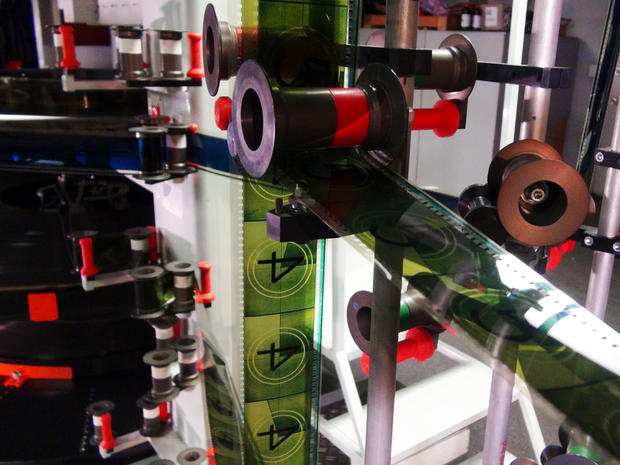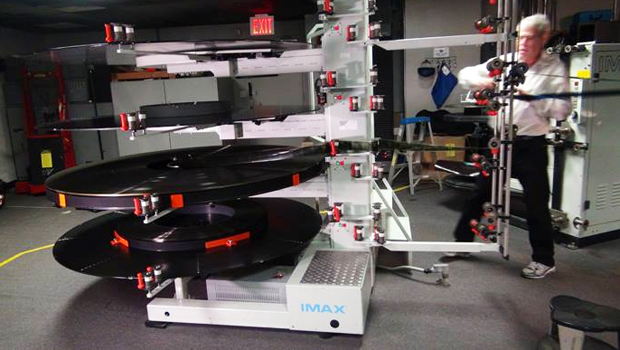In a digital age, "Interstellar" unspools on film stock
Despite the motion picture industry's nearly complete transition to digital production and exhibition, fans of Christopher Nolan are able to attend screenings of his highly-anticipated futuristic epic, "Interstellar," on a decidedly old-school format: large-format 70mm film.
The nearly three-hour movie, opening wide on Friday, was released two days earlier in a handful of U.S. and international theatres that are exclusively screening 70mm IMAX, standard 70mm and 35mm prints, rather than digital projection.
"We like putting our best foot forward," said Greg Foster, senior exec. V.P., IMAX Corp., and CEO of IMAX Entertainment. "The finest filmmakers in the world have a thing for IMAX, whether it's J.J. Abrams, Jim Cameron, Alfonso Cuaron, and none more than Chris Nolan."
More than an hour of "Interstellar"'s running time was shot with IMAX 70mm cameras. "He's designed the movie with IMAX in mind," said Foster.
In fact, the size of a reel holding an IMAX print maxes out at two-and-three-quarter hours, hence "Interstellar"'s two-and-three-quarter hour running time.
Even with the increasing improvement in the quality of digital cameras (seven of the last 15 Academy Award nominees for cinematography were captured digitally), David Keighley, chief quality officer of IMAX, called IMAX film -- with its 12 x 18K resolution and wide dynamic range -- "the gold standard" of image capture.
Keighley said he believes digital's resolution will eclipse film for image capture "in the very near future," but it's not there yet -- and it still can't compare to the organic quality brought about by celluloid's photo-sensitive silver emulsion, whose grain is far finer than the tiniest pixel.
"Chris loves you to see his movies the way he intended: Shot on film and projected on film, so you get all that nuance," Keighley said.
IMAX, which originated with multi-projector and large-format presentations at World Expos in 1967 and '70, grew into a producer of documentaries for planetariums and science museums, with a roster that includes "To Fly," the Oscar-nominated "Eruption of Mount St. Helens," and "The Dream Is Alive" (1985), narrated by CBS News' Walter Cronkite.
"Our business evolved in the late 1990s and early 2000, when we realized that to really expand our audience and bring in a different kind of filmmaker, we had to supplement our documentary moviemaking -- whales, bears, seals and space movies -- with Hollywood," said Foster. "The best way of getting the best movies was forging relationships with the best filmmakers. And that's what we've done."
In 2014, 35 Hollywood releases, including "Lucy, "Transformers: Age of Extinction" and "Captain America: The Winter Soldier," were shot or remastered in IMAX, bringing in three-quarters of a billion dollars at IMAX's 800+ screens.
The two-day early window for cinephiles to experience "Interstellar" on film prints irked some theater owners who had invested in replacing their film projectors with digital -- a change mandated by the Hollywood studios' switch to Digital Cinema Packages (DCP) in place of 35mm film prints. [The TLC Chinese Theatre in Hollywood, which presented the movie's world premiere last week, actually had to re-install the 70mm IMAX projectors that they had mothballed.]
Large-format film projection may remain an artisanal experience, one requiring two projectionists to grapple with the film print.
The movie's 49 reels -- including the native 15-perf 70mm IMAX footage, printed straight off the camera negative -- are wound onto a single reel.
The 600-pound print is then spooled into the IMAX projector, which shines the image onto a screen that -- at Manhattan's AMC Loews Lincoln Square, the largest IMAX house in the U.S. -- measures 100 by 80 feet. What appears has a depth and vibrancy unlike most digital projections -- what Quentin Tarantino has derided as "television in public."
According to the Hollywood Reporter, first-day business for prints of "Interstellar" brought in $1.4 million at 250 domestic screens, including 42 showing 15-perf 70mm IMAX.
But has the success of Nolan's previous IMAX film releases made it easier for him and other filmmakers to see their movies projected on film? "No!" said Foster.
While most film labs have closed shop, celluloid is still (knock wood) being manufactured for discriminating filmmakers, including Paul Thomas Anderson (who shot "The Master" on 65mm), and Tarantino (who will also use 65mm for his next western, "The Hateful Eight"). "Jurassic World," due next summer, was also partially shot on large-format film.
And an IMAX film camera was used for an action sequence of the upcoming "Star Wars: The Force Awakens."
At least Kodak, which teetered on bankruptcy, is still in the game.
"I know the studios are committed in the next couple of years to keep film alive, 'cause we really need that gold standard," said Keighley.
And not just for production, but also preservation, with digital storage of films -- untested and dicey -- about 11 times more expensive than striking archive prints.
"The best way to keep motion pictures alive is to put them on film, even if they're shot digitally," said Keighley.
To watch a trailer for "Interstellar" click on the video player below.
- Critics applaud Christopher Nolan's "Interstellar," mostly (CBS News, 11/07/14)
- Jessica Chastain: "Interstellar" isn't about science, it's about love (CBS News, 10/30/14)
- Matthew McConaughey cried while watching "Interstellar" (CBS News, 11/04/14)
- Gallery: "Interstellar" world premiere red carpet
- Gallery: A night full of stars at "Interstellar" N.Y. premiere
For more info:
- "Interstellar" (Official website)
- Imax



